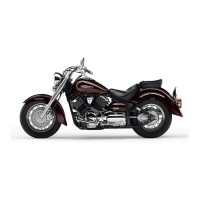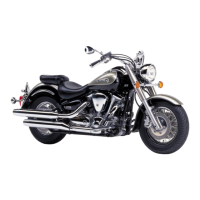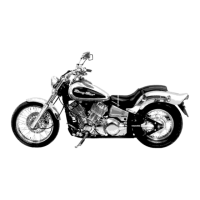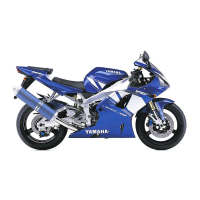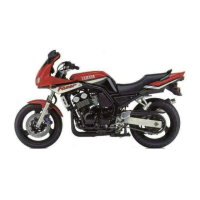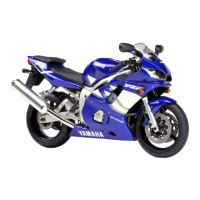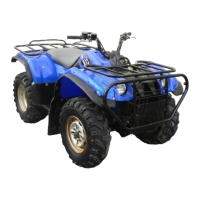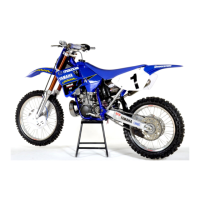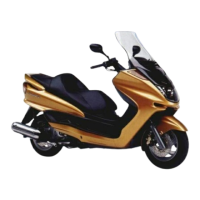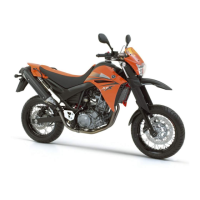Do you have a question about the Yamaha XT600E 2000 and is the answer not in the manual?
Essential guidelines for safe motorcycle operation and visibility in traffic.
Importance of helmets, shields, and protective clothing to prevent injuries.
Risks and legal implications of altering the motorcycle from its original design.
Advice on how adding cargo affects motorcycle stability and handling.
Safety precautions related to fuel handling, flammability, and exhaust fumes.
Identifies the location and meaning of critical safety and warning labels on the vehicle.
Identifies key components visible from the left side of the motorcycle.
Identifies key components visible from the right side of the motorcycle.
Details the location and function of all handlebar controls and dashboard instruments.
Explains the operation of the ignition, lighting, and steering lock mechanism.
Describes the function and meaning of various dashboard indicator lights.
Details the speedometer, odometer, and tripmeter functions for tracking travel.
Explains how to monitor engine speed and stay within the ideal power range.
Covers the function of switches on both left and right handlebars for lighting, signals, etc.
Explains how to operate the clutch lever for gear changes and its safety interlock function.
Describes the operation of the shift pedal for changing gears in the transmission.
Explains how to apply the front brake using the lever on the right handlebar.
Details how to apply the rear brake using the pedal on the right side.
Instructions on how to open and secure the fuel tank cap.
Explains the fuel cock positions (ON, OFF, RES) for fuel supply control.
Describes the function of the choke for starting a cold engine.
Instructions on how to remove and install the motorcycle seat.
Explains the operation of the helmet holder mechanism.
Guide on how to adjust the rear shock absorber spring preload for different loads.
Information on the operation and safety precautions related to the sidestand.
Details the safety functions of the system involving sidestand, clutch, and neutral switches.
A list of vital checks to perform before each ride to ensure safety and proper function.
Step-by-step guide for starting and warming up the engine before riding.
Procedure for starting the motorcycle when the engine is already warm.
Explains how to use the transmission and shift gears for optimal control and performance.
Practical advice on riding techniques to improve fuel efficiency.
Critical guidelines for the initial 1,000 km to ensure engine longevity.
Procedures and safety considerations for parking the motorcycle.
Information on the tools provided with the motorcycle for basic maintenance.
A schedule outlining required maintenance tasks and their intervals.
Instructions for accessing internal components by removing body panels.
Guide on inspecting the spark plug for engine health and proper ignition.
Procedures for checking, changing engine oil, and replacing the oil filter.
Steps to clean the air filter for optimal engine performance and air intake.
Guidance on carburetor adjustment, recommending dealer service for complex tasks.
How to check and adjust the engine's idle speed for smooth operation.
Instructions for checking and adjusting the play in the throttle cable.
Explanation of valve clearance adjustments, recommending dealer service.
Information on tire pressure, inspection, and selection for safe riding.
Checks and maintenance advice for spoke wheels and rims.
Procedure to set the correct free play for the clutch lever for smooth engagement.
Procedure to set the correct free play for the front brake lever.
How to adjust the rear brake pedal position for optimal control.
Guide on inspecting brake pads for wear using indicator grooves.
Importance of checking and maintaining brake fluid levels for effective braking.
Recommends dealer service for brake fluid changes and hose replacements.
Procedure for checking and adjusting the drive chain slack for optimal performance.
Steps for cleaning and lubricating the drive chain to prevent wear.
Instructions for inspecting and lubricating control cables.
Guide on checking pedal operation and lubricating pivots.
Guide on checking lever operation and lubricating pivots.
How to check sidestand operation and lubricate its pivot points.
Information on lubricating rear suspension pivot points.
How to inspect the front fork for damage and proper operation.
Procedure for checking steering bearings for looseness or wear.
How to check wheel bearings for play or smooth rotation.
Information on the maintenance-free battery and safety precautions.
Steps for replacing a blown fuse with the correct amperage.
Instructions for replacing the motorcycle's headlight bulb.
Steps for replacing a burnt-out turn signal bulb.
Instructions for replacing the tail/brake light bulb.
Methods for safely supporting the motorcycle for maintenance tasks.
Procedures for removing and installing the front wheel.
Procedures for removing and installing the rear wheel.
General advice on diagnosing and resolving common motorcycle issues.
Guidelines for cleaning and maintaining the motorcycle's appearance and components.
Procedures for short-term and long-term storage to protect the motorcycle.
Detailed technical data including dimensions, engine, chassis, and electrical systems.
A reference table for converting metric units to imperial units.
Location and recording of key, vehicle, and model identification numbers.
Information on the location and purpose of the model label.
Details Australian regulations regarding motorcycle noise control systems.
Essential guidelines for safe motorcycle operation and visibility in traffic.
Importance of helmets, shields, and protective clothing to prevent injuries.
Risks and legal implications of altering the motorcycle from its original design.
Advice on how adding cargo affects motorcycle stability and handling.
Safety precautions related to fuel handling, flammability, and exhaust fumes.
Identifies the location and meaning of critical safety and warning labels on the vehicle.
Identifies key components visible from the left side of the motorcycle.
Identifies key components visible from the right side of the motorcycle.
Details the location and function of all handlebar controls and dashboard instruments.
Explains the operation of the ignition, lighting, and steering lock mechanism.
Describes the function and meaning of various dashboard indicator lights.
Details the speedometer, odometer, and tripmeter functions for tracking travel.
Explains how to monitor engine speed and stay within the ideal power range.
Covers the function of switches on both left and right handlebars for lighting, signals, etc.
Explains how to operate the clutch lever for gear changes and its safety interlock function.
Describes the operation of the shift pedal for changing gears in the transmission.
Explains how to apply the front brake using the lever on the right handlebar.
Details how to apply the rear brake using the pedal on the right side.
Instructions on how to open and secure the fuel tank cap.
Explains the fuel cock positions (ON, OFF, RES) for fuel supply control.
Describes the function of the choke for starting a cold engine.
Instructions on how to remove and install the motorcycle seat.
Explains the operation of the helmet holder mechanism.
Guide on how to adjust the rear shock absorber spring preload for different loads.
Information on the operation and safety precautions related to the sidestand.
Details the safety functions of the system involving sidestand, clutch, and neutral switches.
A list of vital checks to perform before each ride to ensure safety and proper function.
Step-by-step guide for starting and warming up the engine before riding.
Procedure for starting the motorcycle when the engine is already warm.
Explains how to use the transmission and shift gears for optimal control and performance.
Practical advice on riding techniques to improve fuel efficiency.
Critical guidelines for the initial 1,000 km to ensure engine longevity.
Procedures and safety considerations for parking the motorcycle.
Information on the tools provided with the motorcycle for basic maintenance.
A schedule outlining required maintenance tasks and their intervals.
Instructions for accessing internal components by removing body panels.
Guide on inspecting the spark plug for engine health and proper ignition.
Procedures for checking, changing engine oil, and replacing the oil filter.
Steps to clean the air filter for optimal engine performance and air intake.
Guidance on carburetor adjustment, recommending dealer service for complex tasks.
How to check and adjust the engine's idle speed for smooth operation.
Instructions for checking and adjusting the play in the throttle cable.
Explanation of valve clearance adjustments, recommending dealer service.
Information on tire pressure, inspection, and selection for safe riding.
Checks and maintenance advice for spoke wheels and rims.
Procedure to set the correct free play for the clutch lever for smooth engagement.
Procedure to set the correct free play for the front brake lever.
How to adjust the rear brake pedal position for optimal control.
Guide on inspecting brake pads for wear using indicator grooves.
Importance of checking and maintaining brake fluid levels for effective braking.
Recommends dealer service for brake fluid changes and hose replacements.
Procedure for checking and adjusting the drive chain slack for optimal performance.
Steps for cleaning and lubricating the drive chain to prevent wear.
Instructions for inspecting and lubricating control cables.
Guide on checking pedal operation and lubricating pivots.
Guide on checking lever operation and lubricating pivots.
How to check sidestand operation and lubricate its pivot points.
Information on lubricating rear suspension pivot points.
How to inspect the front fork for damage and proper operation.
Procedure for checking steering bearings for looseness or wear.
How to check wheel bearings for play or smooth rotation.
Information on the maintenance-free battery and safety precautions.
Steps for replacing a blown fuse with the correct amperage.
Instructions for replacing the motorcycle's headlight bulb.
Steps for replacing a burnt-out turn signal bulb.
Instructions for replacing the tail/brake light bulb.
Methods for safely supporting the motorcycle for maintenance tasks.
Procedures for removing and installing the front wheel.
Procedures for removing and installing the rear wheel.
General advice on diagnosing and resolving common motorcycle issues.
Guidelines for cleaning and maintaining the motorcycle's appearance and components.
Procedures for short-term and long-term storage to protect the motorcycle.
Detailed technical data including dimensions, engine, chassis, and electrical systems.
A reference table for converting metric units to imperial units.
Location and recording of key, vehicle, and model identification numbers.
Information on the location and purpose of the model label.
Details Australian regulations regarding motorcycle noise control systems.
| Displacement | 595 cc |
|---|---|
| Bore x Stroke | 95.0 mm x 84.0 mm |
| Compression Ratio | 8.5:1 |
| Cooling System | Air-cooled |
| Fuel System | Carburetor |
| Ignition | CDI |
| Transmission | 5-speed |
| Final Drive | Chain |
| Front Suspension | Telescopic fork |
| Front Brake | Single disc |
| Rear Brake | Drum |
| Front Tire | 90/90-21 |
| Rear Tire | 120/90-17 |
| Seat Height | 855 mm |
| Starting System | Electric |
| Lubrication | Wet sump |
| Clutch Type | Wet, multiple-disc |
| Fuel Capacity | 15 liters |
| Engine Type | Air-cooled, 4-stroke, SOHC, 4-valve |
| Rear Suspension | Swingarm |


